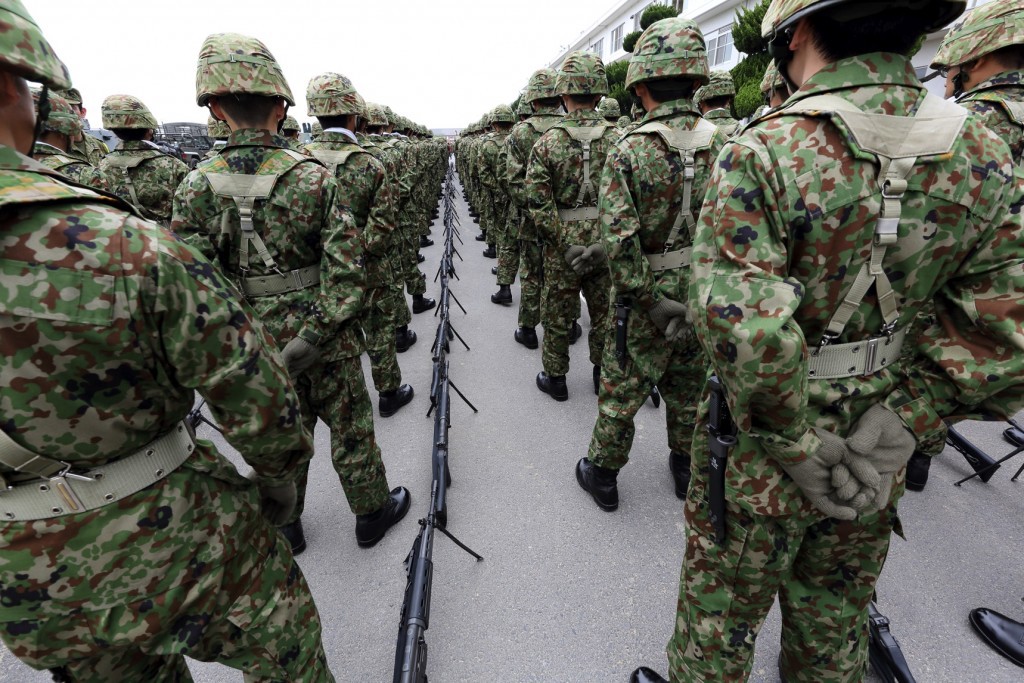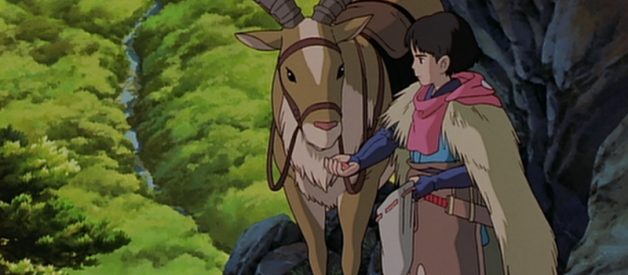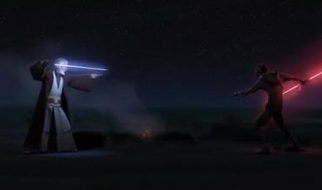People can not easily let go of the culture in which they were born and raised. So people fight, and war never ends. ?Princess Mononoke? is a work that depicts such a collision of cultures.
Theme of the movie: ?Clash of cultures?
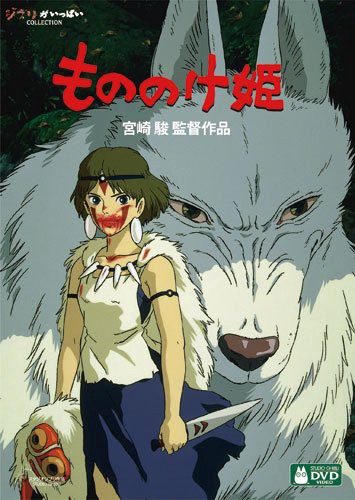
Ashitaka?s culture: ?Coexistence of humans and beasts?
The hero, Ashitaka is a member of a tribe who has lost their fight against the Yamato Court, and has fled the rule of Yamato.
In Ashitaka?s tribe, humans and animals coexist in an equal relationship. A symbol of this is the relationship between Ashitaka and Yakul.
Ashitaka and Yakul share their foodAshitaka talks to Yakul, encourages him when he is injured, but a particularly memorable scene is when, during their journey, Ashitaka and Yakul both eat the same food.
Today it is difficult to imagine humans and animals eating the same food. In reality there may be people who feed their pets the same food that they eat, however, in our minds, we separate the food that animals eat from the food humans eat.
As a proof of this, most of us cannot eat something that has already been in the mouth of an animal. This irreversible thinking is due to the fact that we call the food animals (pets and domesticated animals) eat ?feed?, separating it in our minds from the food humans eat.
In other words, the fact that they share the same food is proof that Ashitaka considers humans and animals as equals.
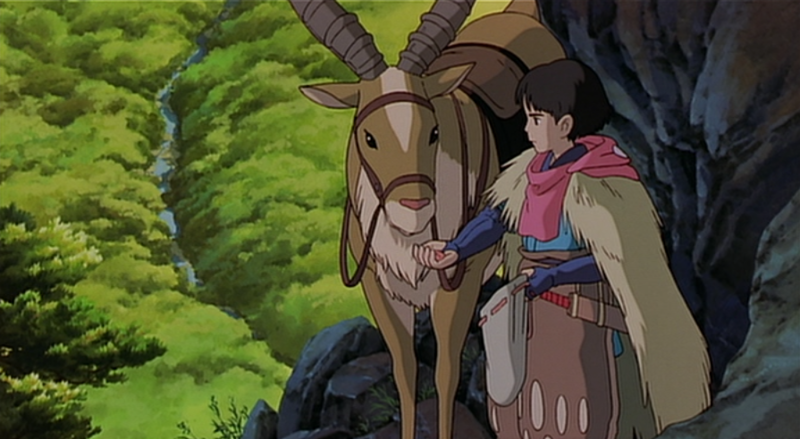 Ashitaka and Yakul eating. Ashitaka first gives the food to Yakul, then he eats himself.
Ashitaka and Yakul eating. Ashitaka first gives the food to Yakul, then he eats himself.
We get a glimpse of the relationship of Ashitaka and Yakul.
Ashitaka?s oath to leave the villageAfter receiving the curse of the demon, Ashitaka has to leave the village. At this time, he cuts his hair, a ritual representing his oath that he will never come back to his village again.
This is the moment when Ashitaka decides to live outside of the culture he grew up in.
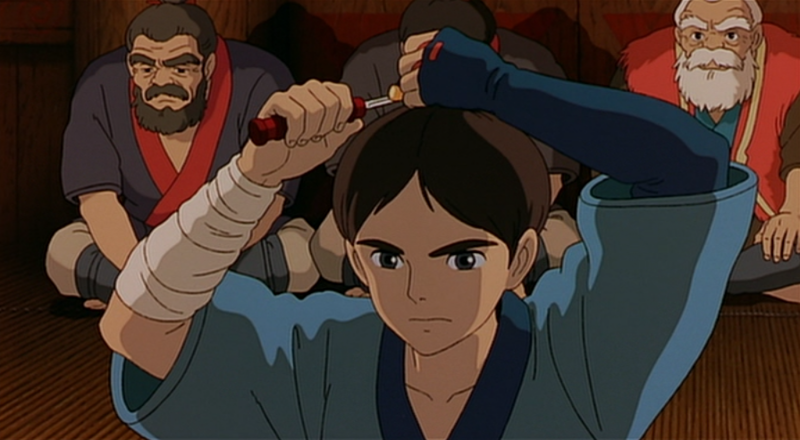 Ashitaka cutting his hair. A ritual representing the oath that he will never come back to his village.
Ashitaka cutting his hair. A ritual representing the oath that he will never come back to his village.
During his journey, Ashitaka arrives at a village. There are fields and a market there.
 Instead of harvesting the blessings of nature, they are are harvesting crops grown in the fields by the hands of men.
Instead of harvesting the blessings of nature, they are are harvesting crops grown in the fields by the hands of men.
If we compare it to Ashitaka?s culture, it looks like it is a lot more civilized, but the man made parts are what add to the impression that Ashitaka has come to a land with a different culture from what he has known until now.
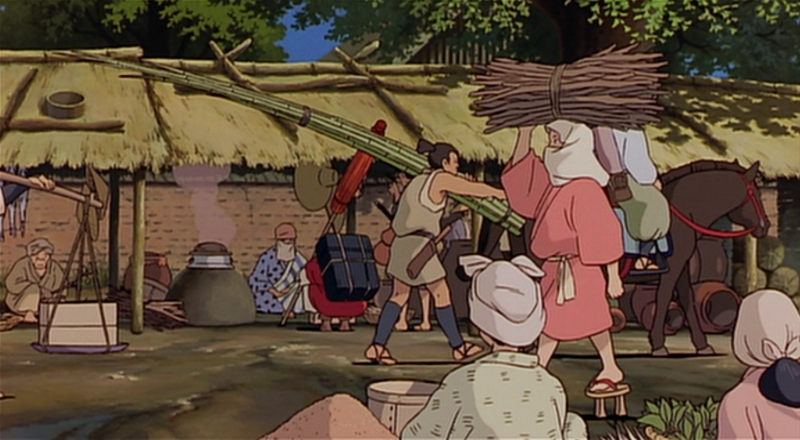 At the market, instead of bartering for goods, they exchange goods from money.
At the market, instead of bartering for goods, they exchange goods from money.
Jigo?s culture ?The Emperor?s culture?
In the village, Ashitaka meets Jigo. Jigo is the leader of the ?Karakasa-ren?, with an edict from the Emperor. Basically, he belongs to the Emperor?s culture.
Below there are a few of Jigo?s lines from the movie. Jigo is one of the rare type of people in the movie ?Princes Monoke?, who believes only what they see with their own eyes, instead of believing in gods or eternal life.
Jigo seems to play the percentages and seems to have a kind of ?merchant?s temperament? in him.
Jigo, who believes only what he sees
?We?re after a god, not just a beast.?
Jigo?s line about conquering the Forest Spirit Shishigami. We can see that Jigo sees the Forest Spirit more as a beast, not as a god.
?I?m sure I don?t know what the Emperor believes.?
His line regarding the reason why he is hunting for the Forest Spirit?s head.
We can see that he doesn?t think too deeply about the reasons for the Emperor?s edict.
 Jigo. Hunts for the head of the Forest Spirit in the name of the Emperor.
Jigo. Hunts for the head of the Forest Spirit in the name of the Emperor.
Also, at the end of the movie, there is his line: ?You can?t win against fools?. ?Fools? here may refer to two different things: ?fools who do not understand the rule of the Emperor? or ?fools who do not know where their interest lies?.
Culture of San (Princess Mononoke) ?Pure love for her mother?
When Ashitaka continues his journey in the direction that Jigo told him, he finds the people of Irontown, scarred by the war.
While Ashitaka was trying to help these people, San appeared in front of his eyes, tending to the wounds Moro got while fighting. San, a human, tending to the wounds of a beast, Moro.
This gesture surpasses the boundaries between man and animal, and as a gesture of pure love towards her mother, to Ashitaka, it looked beautiful.
 San tending to the wounds of her mother
San tending to the wounds of her mother
San trying her best to save her mother, Moro. To Ashitaka who had to discard his culture because of the hatred of the demon god, San?s gesture looks beautiful.
Irontown?s culture ?Culture in conflict with nature?
Since Ashitaka wants to save the injured men, he attempts to go through the mountains. That is where the Kodama appeared in front of Ashitaka.
The opposing cultures of Ashitaka and the people of IrontownAshitaka says the following referring to the Kodama running ahead of them:
?Are you showing us the way, or just getting us more lost??
From this line we can see that Ashitaka belongs to a culture where men surrender themselves to nature.
On the other hand, the injured Koroku is quite pessimistic about the Kodama:
?I?m pretty sure they?re not trying to help us get home.?
This may be because Koroku belongs to a culture which is in conflict against nature.
 Koroku scared of the Kodama
Koroku scared of the Kodama
Koroku, who, unlike Ashitaka, belongs to a culture that tries to control nature with the power of man, cannot surrender himself to the Kodama.
Ironworks made by destroying nature
So Ashitaka and the injured men traveled safely through the mountains and arrived to Irontown.
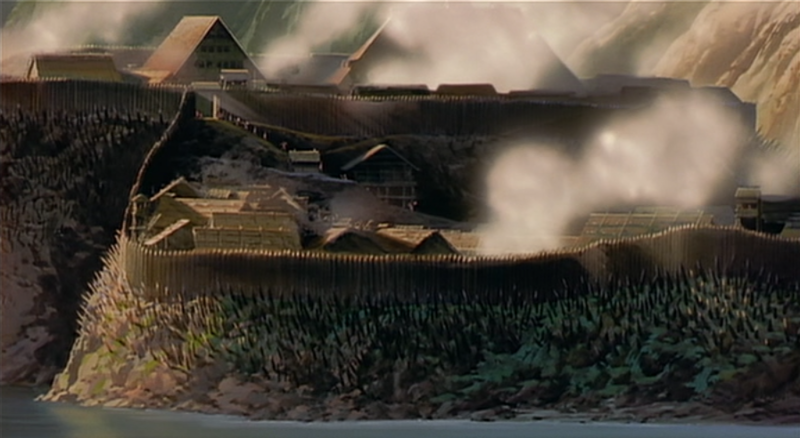 The ironworks
The ironworks
The ironworks were built by breaking down the mountain, they are portrayed as a symbolic presence in conflict with nature. These people break down the mountain, make iron and fight with nature, Ashitaka learns that it was the bullet made by these people that cause the demon god to appear.The culture of the people of Irontown is, of course, not simply a culture which destroys nature. While they are fighting against nature, they are also protecting something.
The thing the people of Irontown are protecting are the prostitutes and the lepers.
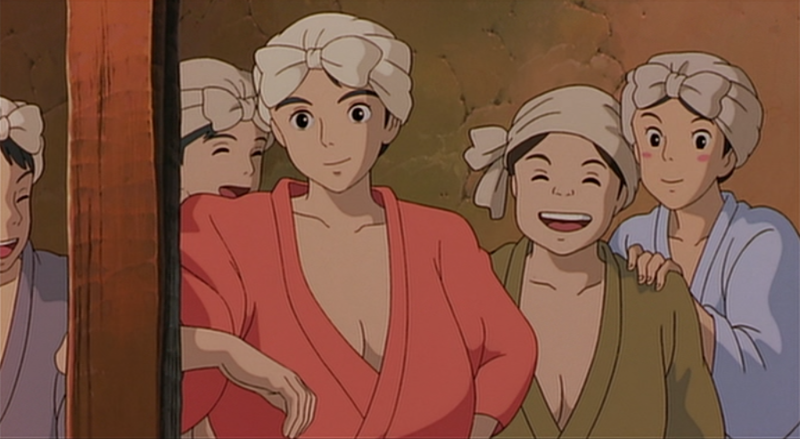 Prostitutes and lepers.The women of Irontown. They make a living by working at the ironworks.
Prostitutes and lepers.The women of Irontown. They make a living by working at the ironworks.
These bright and strong women, who were once socially disadvantaged, are one of the things the people of Irontown are trying to protect from the beasts. Also, they gave a job and food and drinks to the lepers, who were shunned by people scared that the sickness would infect them. They saved people.
The people of Irontown were trying to build a community that would protect people in a disadvantaged position. How did these people look in Ashitaka?s ?eyes unclouded??
Before long, Ashitaka witnesses the fight between the people of the Irontown and San. For Ashitaka, this is the first time he sees a fight between humans and beasts.
Ashitaka has chosen to save both
Humans, like the village people and Jigo, who is after the head of the Forest Spirit, face off against the ?mononoke? beasts that San belongs to and tries to save.
Ashitaka is attracted to both cultures, but he cannot belong to either of them. He tries with all his might to find a way to live together, to coexist, but in the end his wish is not realized and he tries to leave.
In the end, the answer Ashitaka came up with was: ?I will leave Irontown.? As it turned out, he could not become one of them.
That is when he finds out that Irontown is attacked by samurai.
There are some memorable lines spoken Lady Eboshi and Jigo to Ashitaka, who is not (cannot be) on either?s side.
Lady Eboshi:
?So it?s don?t kill the Forest God, now you want us to kill the samurai instead??
Jigo:
?Who?s side on is he anyway??
Having a different culture does not mean they have to fight.
Eventually both Lady Eboshi and Jigo are thinking in dualistic terms, pitting cultures against each other, humans against beasts, Irontown against the samurai.
However, Ashitaka replies to them both:
?What I want is that the humans and the forest live together in peace!?
For Ashitaka, different cultures does not have to mean war. Ashitaka, who seeks the way for coexistence, says this line to San at the end, when giving back the head to the Forest Spirit:
?Human hands must return it.?
Rather than ending the fight between humans and beasts by one of them winning, Ashitaka was aiming for an outcome mutually recognized by both.
The message of ?Princess Mononoke
?Let?s live together.?
Eventually, it is not easy to integrate into a different culture. Having said that, when they come face to face, conflict will occur.
Even San, who was originally human, can no longer live in the human world, and this may be due to her past.
Ashitaka also cannot belong to the beasts. Even though he has already abandoned his culture once, in the end he chose to live in Irontown with the humans.
That?s when Ashitaka says to San in the end:
?I understand. You go live in the forest and I?ll help them rebuild Irontown. I?ll always be near. Yakul and I will come and visit you whenever we can.?
The difference between cultures did not end in assimilation or conflict, but he was able to start a way of coexistence.
If we think of it in a modern context, the movie was released in 1997. Six years before was the start of the Gulf War, Japan?s Self-Defence Forces were dispatched to the Persian Gulf.
In 1999 the Emergency at Periphery Law was passed. In 2001 synchronized terrorist attacks occurred in the United States and the War in Afghanistan broke out. Under the influence of the Iraq war in 2003, Japan has passed the Iraq Reconstruction Special Measures Law.
Defeated, Japan decided not to participate in war anymore, however, Japan cannot help but be connected to war in this world. Cultures collide.
So how should Japan, or the Japanese people, intervene?
Should they be on the United States? side? Or Iraq?s side?
However, us Japanese can only act as Japanese. When cultures collide and war breaks out, we cannot take sides with either culture.
We can only mutually acknowledge that we are different and try to coexist. In the present day, when war seems never ending, we can hear the message that lets us know the position Japanese people should take.
